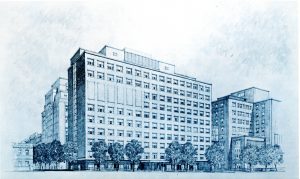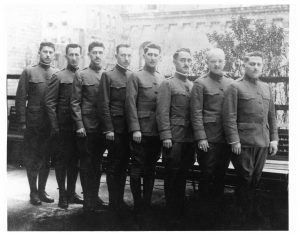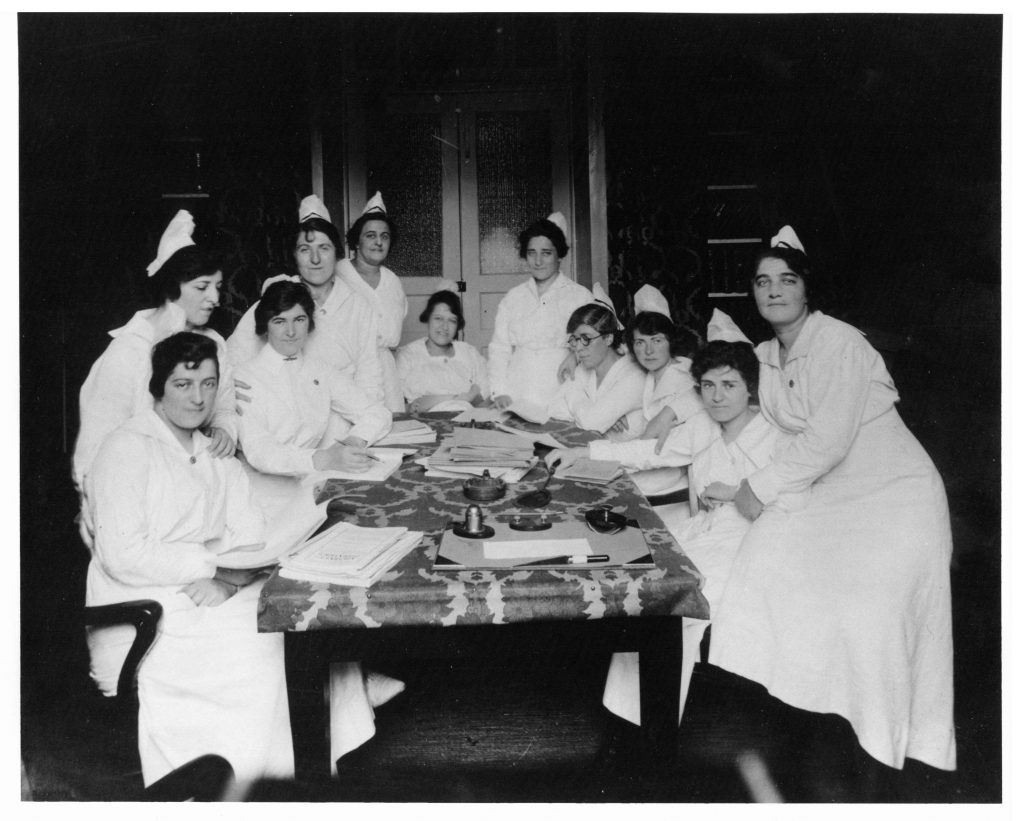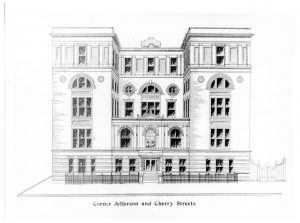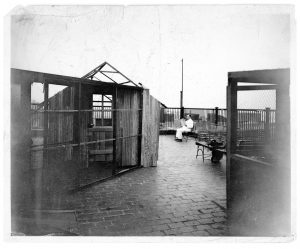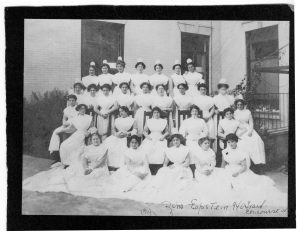Jan 10, 2022
In a previous blog post, we looked at Beth Israel Hospital’s role in the 1918 Influenza Epidemic. Since then, we’ve done further research into the World War I correspondence in the Beth Israel records, as well as the Beth Israel Board of Directors and Committee minutes, which both provided rich details to supplement this history.
In early March 1918, influenza had reached New York. By March 25, 1918, an unknown correspondent (likely Louis J. Frank, Beth Israel Hospital superintendent) wrote that there was “quite an epidemic in the City of Grippe,” referring to New York City as literally the “City of the Flu”. As World War I continued on, many Beth Israel workers had joined the war effort, and their correspondence with the hospital describes the epidemic on the front lines. The first wave of the flu was relatively mild, and on May 13, 1918, Dr. Alfred A. Schwartz of the American Expeditionary Force, reported as much from France:
“I have been appointed Otolaryngologist to the contagious disease wards at the camp hospital and altho [sic] the title sounds like work, there must first be complications to the infectious diseases, and secondly…there must be some patients to have the diseases, and fortunately there is little to do.”
As the second, more deadly wave swept the world, the topic of influenza became more pressing in the correspondence, and was increasingly addressed in the Board minutes. In the November 17, 1918, minutes, the Board noted that back on the home front in New York, Beth Israel attended to “50 to 60 cases of Influenza a day during the height of the epidemic and…our records of cures was high, and our record of deaths was very low.” This is a significant deviation from the previous blog post, which stated that only twenty-nine patients total were treated during the epidemic at Beth Israel. Sources conflict on this point.
Staffing was amongst the most pressing issues at this time – with much of the medical staff overseas, Louis J. Frank, himself recovering from the flu, commented in a letter from October 23, 1918: “Our whole force is gone. If you were to come back today, you wouldn’t find a familiar face…From a house staff of 15 we have been reduced to a staff of five, and of the five, three have been laid up on account of influenza.” He goes on to describe the issue of hiring enough nurses, which was making him “frantic.” Superintendent Frank was a proponent of the conscription of women, “especially those women who have the vote,” to counteract staffing shortages in nursing in the war and at home.
The Board of Directors’ minutes reflect similar staffing concerns. The minutes for November 17, 1918, stated: “During the epidemic the Surgical Staff consisted of one man, the others became infected with the disease. On the Medical side we only had two men, the others also sick.” This appears to have resulted in redeployment of other clinical workers, and the Board resolved on “the discontinuance of the work of the Polio Department on account of the epidemic of Influenza and Pneumonia to release the doctors and nurses connected with the clinic for the more important work.” The minutes also noted that the “pupil nurses” from Beth Israel Training School for Nurses (today’s Phillips School of Nursing at MSBI) “after their day’s work was over, did extra work in the district on these cases, spending an hour or two on emergency cases requiring special care.”
The close of 1918 marked a turning point. With the War over, and a dwindling number of cases following the peak of the second wave, the end was in sight. In a letter from November 27, 1918, Superintendent Frank wrote:
“Things are getting into shape at the Hospital. We were considerably upset on account of the War, shortage of help, doctors, nurses, the Influenza epidemic, and the general anxiety, but with victory came a relaxation and we are now awaiting the homecoming of you men who have done so much to achieve this victory.”
The Board also noted, grimly, on November 17, 1918, that Beth Israel was “the only Hospital [in New York City] that didn’t lose a nurse, a doctor, or an employee by death.” On January 19, 1919, the Board moved to give House Staff and pupil nurses bonuses for their contributions and made especial note of the nurses’ service: “pupil nurses…after their trying [work and school] day of 12 and many times 14 hours, went out in the tenement houses and did extra work for several hours. Of course, this work was not for patients of the Hospital, but it was nevertheless our work, for they were the poor sick of our neighborhood.”
On November 23, 1919, the Board made note of the U.S. Public Health Service’s prediction that the influenza epidemic would return. Fortunately, this never came to pass. By 1920, the virus mutated to cause only ordinary cases of the seasonal flu, and the epidemic was effectively over.
Sources:
More resources on Mount Sinai Health System Hospitals and World War I are available here.
Authored by Stefana Breitwieser, Digital Archivist
Sep 28, 2021
See Building Beth Israel, Part 1: Foundations for the first part of this series. An interactive map of Beth Israel historical locations is available here. More archival material about the Jefferson and Cherry Streets location is here.
For much of the 1890s, the first decade of its existence, the location of Beth Israel Hospital was a moving target. The hospital moved from a factory loft, to an “old-fashioned parlor floor,” to two different rented hospital facilities. In its final locations during this period, split between buildings at 206 East Broadway and 195 Division Street, Beth Israel Hospital was financially solvent for the first time, enabling it to finally buy land of its own. In 1896, Beth Israel purchased a plot of land at Jefferson and Cherry Streets for the construction of a new hospital building.
In 1899, the Beth Israel Board of Directors chose a design for the new hospital. The cornerstone of the building was laid on April 1, 1900.
Much of the early funding for the new location was put up by Beth Israel’s Board of Directors, which, in addition to a mortgage, allowed for the purchase of the lot. However, the cost for the chosen design was well above initial expectations, and the final estimate was around $200,000 (about $6.5 million in 2021 dollars), requiring a significant fundraising effort.
On May 26, 1902, the new Beth Israel Hospital at Jefferson and Cherry Streets was dedicated. It included 134 beds, with male, female, and maternity wards as well as private rooms. It featured a solarium, a common feature for hospitals at that time, in addition to outdoor space on the roof for staff and patient use. The Beth Israel Hospital Training School for Nurses was founded in 1904 and moved into this building. (Today, it is the Phillips School of Nursing at Mount Sinai Beth Israel.)
By August 1912, a physiological chemistry laboratory opened at Beth Israel under the direction of Max Kahn, PhD. The laboratory was located on the top floor and could comfortably hold five people. Additionally, after extensive delays, a children’s ward opened in January 1919, but it was forced to close six months later because of the nursing shortage caused by the Influenza Epidemic of 1918. Both the children’s and maternity wards were closed and re-opened periodically, based on available financial and staff support.
As early as 1915, the Beth Israel Board of Directors began to purchase property on Livingston Place along Stuyvesant Square Park. Plans to move to this new location were delayed first by World War I, and then by the influenza epidemic. Construction began in earnest in 1922, and Beth Israel finally moved to its current location in the Dazian Pavillion in 1929, giving up the Jefferson and Cherry Streets location. While it wasn’t the Hospital’s final location, Jefferson and Cherry Streets is where Beth Israel Hospital came of age and began to resemble the hospital of today.
Authored by Stefana Breitwieser, Digital Archivist
Aug 31, 2021
The first meeting related to the founding of Beth Israel Hospital was held on December 1, 1889 at 165 East Broadway. Healthcare was greatly needed in New York’s Lower East Side, whose residents, largely recent Jewish immigrants, were affected by poverty, close living quarters, and dangerous working conditions. From a 1901 essay on early Beth Israel history:
“The origin of the idea of this institution sprang from the poor themselves. So urgent was the need for such a local hospital, that in spite of the lack of support, and even of the discouragement of those in position to assume such a task, the poor themselves, by taxing their hard earned [sic] wages, gained by the sweat of their brows, established the association and undertook to support the Hospital…It serves to demonstrate the noble Jewish heart. These workingmen when they could earn their bread and butter were willing to contribute their 25 cents a month to help their neighbors in distress.”
In the face of “meagre [sic] and uncertain support,” the founders first endeavored to begin a dispensary, rather than a full-scale hospital, and in May 1890, rented a loft in a factory on Birmingham Street. (This street no longer exists, but today would be between Henry Street and Madison Street, just underneath the Manhattan Bridge.) The building was described as “most unsuitable and the accommodations about as poor as can be imagined” but still attracted more patients than could be treated, speaking to the great need for medical care in this neighborhood at the time.

Click here for an interactive map of Beth Israel historical locations
After two months at the Birmingham Street location, the Beth Israel outpatient dispensary moved to 97 Henry Street in July 1890. Described as an “old-fashioned parlor floor,” it was “much better situated” and the dispensary remained there for ten months.
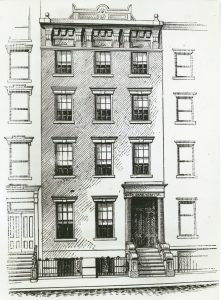
Sketch of the 206 E Broadway location of Beth Israel Hospital, circa 1892-1902.
In May 1891, Beth Israel moved to 196 East Broadway. With twenty beds, this is the first Beth Israel location to include inpatient services in addition to the outpatient dispensary. The hospital includes two house staff: Abraham Hymanson, MD, is the first House Physician, and Wolfgang Kaplan, MD is Assistant House Physician.
Embroiled in a financial crisis, Beth Israel moves again in May 1892, splitting their services across buildings at 206 East Broadway and 195 Division Street. With lower rent and more space, including thirty-four beds, Beth Israel was financially solvent for the first time. The Division Street building was renovated one floor at a time for inpatient and outpatient use.
Beth Israel Hospital remained in this location for over a decade, before moving to its location at Jefferson and Cherry Streets in 1902, and finally its current location at the Dazian Pavillion in Stuyvesant Square in 1929. The history of both of these Beth Israel Hospital locations will be addressed in future posts.
Sources:
Authored by Stefana Breitwieser, Digital Archivist
May 18, 2018
By some remarkable coincidence, many Mount Sinai Health System buildings have been dedicated or opened in May.
The Beth Israel Hospital opened its first facility in a rented loft in May 1890 and then moved to 196 Broadway the next year. In May of 1892 they moved again, this time to 206 E. Broadway and 195 Division St. Beth Israel remained at this location until the completion of the Jefferson & Cherry Street building in 1902. Beth Israel did not have another May opening until May 15, 1966 when the Linsky Pavilion opened.
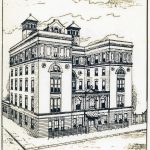
Beth Israel’s Jefferson and Cherry Street location

The Linsky Pavilion, which opened in May 1966
On May 17, 1855, a religious service was held to inaugurate the opening of The Jews’ Hospital in the City of New York, which became The Mount Sinai Hospital in 1866. Presiding at the inauguration was Rabbi J.J. Lyons, with Rabbis Leo, Sternberger, Rubin, Cohen, Waterman, Schickler and Tebrich serving as cantors.

The original building of The Mount Sinai Hospital
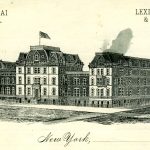
The second site of the Hospital
When Mount Sinai had outgrown this site, the Trustees decided to move uptown to the block of Lexington Avenue between 66th and 67th Streets. The cornerstone for the new hospital was laid on May 25, 1870 and the completed hospital was opened on May 29, 1872.

The 1904 building along 100th Street
Within 25 years, the Hospital had again filled its site and decided to move to its current home next to Central Park, between 100th and 101st Streets. The Park ensured that the hospital would not again get surrounded by the bustle of the City’s streets. The cornerstone for this new hospital was laid on May 22, 1901. In May 1922, Mount Sinai marked the completion of a massive expansion project that extended the hospital across 100th Street down to 99th Street. This included 1184 5th Avenue, which today is the oldest building on the Mount Sinai campus.
On May 23, 1952, The Mount Sinai Hospital celebrated the dedication of the Klingenstein Pavilion on 5th Avenue.
This was built as Mount Sinai’s Maternity Pavilion, and remains the home of our OB-GYN department. At the same event, the Atran Laboratory and the Henry W. Berg, MD Laboratory buildings were both dedicated as well.

The Klingenstein Pavilion on 5th Avenue
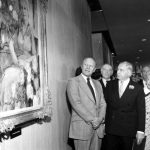
Vice President Ford and Walter Annenberg looking at the portrait of Mrs. Annenberg at the dedication in 1974
And finally, in perhaps Mount Sinai’s biggest dedication, on May 26, 1974, the new Mount Sinai School of Medicine welcomed Vice President Gerald Ford and the Annenberg family to celebrate the formal dedication of the Annenberg Building. When this building opened, it was the thought to be the largest space in this country devoted to medical education.
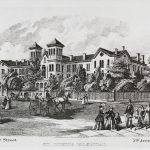
St. Luke’s Hospital on 5th Avenue
The Mount Sinai Hospital was not alone in its fascination with May for buildings. On May 21, 1857, the St. Luke’s Hospital chapel opened at the Hospital’s first site and a year later (May 13, 1858) the hospital itself opened at 5th Ave between 54th and 55th Streets.
The Woman’s Hospital in the State of New York, which became the Women’s Division of St. Luke’s Hospital in 1952, also had a May dedication tradition. On May 4, 1855 the Woman’s Hospital was opened at 83 Madison Avenue. Almost 50 years later, on May 17, 1904, the cornerstone was laid at a new site at Amsterdam Avenue and 110th Street.

The first home of the Woman’s Hospital
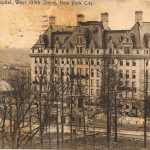
The 1904 west side Woman’s Hospital building
Finally, on May 25, 1965 the Woman’s Hospital opened in a separate building on the St. Luke’s campus on Amsterdam Avenue and 114th Street.
